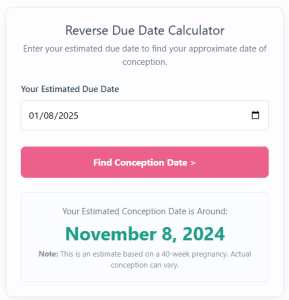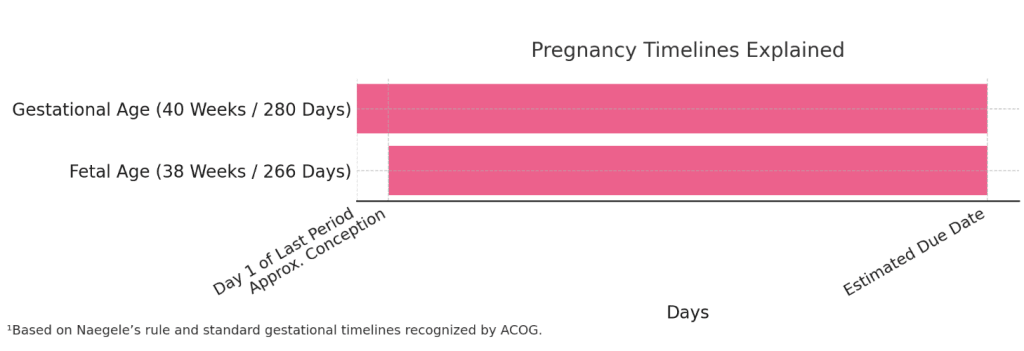Enter your due date or an early-ultrasound date. We’ll estimate your conception date, most-likely intercourse day, a fertile window, and your LMP.
Reverse Due Date Calculator
Why Our Calculator May Show a Different Date
You might notice our result is different from some other online calculators. This is because our tool reports an Estimated Conception Date (Fetal Age) by inverting standard obstetric dating (EDD = ovulation + 266 days).
Many other tools make the common mistake of calculating your Last Menstrual Period (LMP) date by simply subtracting 40 weeks (280 days). This is incorrect, as conception happens about two weeks after your last period.
Our calculator correctly subtracts ~38 weeks (266 days) to pinpoint the actual estimated date of conception.
How to Use This Calculator
Using our calculator is simple. Follow these three steps to get your estimated conception date in seconds.
- Enter Your Due Date: Click on the input field labeled “Your Estimated Due Date.” A calendar pop-up will appear. If you don’t know your due date, try our Pregnancy Due Date Calculator.
- Select the Date: Navigate to the correct month and year and select the date your doctor or midwife provided as your estimated due date (EDD).
- Find Your Date: Click the “Find Conception Date >” button. Your result will appear below after a brief calculation.

The Science Behind Conception Dating
The method for calculating your conception date is the direct inverse of how your due date was likely calculated in the first place. It’s based on established medical timelines for human gestation.
The key is to understand the difference between “gestational age” and “fetal age.”
Gestational Age (The 40-Week Clock): Clinicians calculate a pregnancy as lasting 40 weeks (280 days). This clock starts on the first day of your Last Menstrual Period (LMP). This is a practical standard because the LMP is a firm, known date, whereas the exact day of conception is usually unknown.
Fetal Age (The 38-Week Reality): Conception (fertilization) typically occurs around ovulation, about 14 days after the LMP begins. This means the fetus is actually developing for about 38 weeks (266 days), not 40.
Our calculator uses the more accurate fetal age timeline. It takes your due date and subtracts 266 days to pinpoint the most probable window for conception.
Calculation: Your Due Date – 266 Days = Estimated Conception Date

¹This estimation is based on Naegele’s rule and standard gestational timelines recognized by organizations like the American College of Obstetricians and Gynecologists (ACOG).
Frequently Asked Questions
This information is for educational purposes only and is not a substitute for professional medical advice, diagnosis, or treatment. Always consult with a healthcare provider for any health concerns.
References
¹ American College of Obstetricians and Gynecologists. (2017). Methods for Estimating the Due Date. Committee Opinion No. 700.
